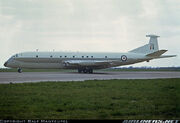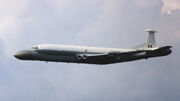Hawker Siddeley/British Aerospace/BAE Nimrod variants
MR.1
Initial production variant, replaced the Shackleton MR.3. 46 aircraft served in 5 RAF squadrons (4 in the UK, 1 in Malta), plus an Operational Conversion Unit. Initially Shackleton crews were not enthusiastic about the aircraft because it did not represent much of an advance over that aircraft, however they soon came to appreciate the Nimrod’s qualities, such as a quieter and smoother ride, which reduced crew fatigue. The Nimrod, being a jet aircraft, was also able to deploy to its patrol aircraft and it was found that submerged submarines found it harder to detect the aircraft when compared to propeller Maritime Patrol Aircraft.
R.1
The secretive ELINT, SIGINT and COMINT variant of the Nimrod. It could be distinguished from the ASW variant by a lack of a MAD boom and additional aerials on the top of the fuselage. The R.1 served extensively in the Falklands War, World War Three and in a number of minor conflicts since then. Continuously upgraded and modified throughout its service, when retired the R.1 was a very different aircraft from the one that had entered service in 1974.
MR.2
First major upgrade of the Nimrod. Added a new radar – the Searchwater – new electronics and ESM pods on the wingtips. During the Falklands War several Nimrods were modified to allow them to refuel in midair, gaining the designation MR.2P, although once the whole fleet had been modified the ‘P’ was dropped. It was during this war that the Nimrod was modified to carry the AIM-9L Sidewinder missile, however it would not be until World War Three that a Nimrod would actually score any kills, several Tu-95s, Tu-142s and Il-38s falling victim to the ‘Mighty Hunter’. The MR.2 was continuously upgraded throughout its service, remaining a cutting-edge and popular MPA right up until it was withdrawn in 2005.
Shortly after World War Three broke out BAe discovered that the jigs and tooling for the Nimrod had not been disposed of, as previously thought, but had been carefully preserved in a remote warehouse. This allowed production of Nimrods to resume, both to replace losses and expand the MPA fleet. It would also have important consequences when the planning for the MRA.4 (q.v) variant began.
AEW.3
A rare failure in the Nimrod story, only two aircraft of this variant flew, although 11 airframes had been allocated for the project. Problems with the GEC-Marconi radar and integration problems led to the project being dropped shortly after the outbreak of war. However BAe realised that a lot of the development work had not been totally wasted and that a larger airframe would solve some of the problems as a larger and more powerful computer could be carried in it, leading to the development of the VC10 based Guardian AEW.1, but that is another story.
MRA.4
In the early to mid-90s is became clear that the MR.2 could only continue to be upgraded for so long. What was really needed was a wholly new aircraft. Two variants of the P-3C Orion and the proposed French Atlantique 3 were studied as potential replacements, however in the RAF’s view the only replacement for a Nimrod was another Nimrod.
Fortunately BAe and Rolls Royce had been studying major Nimrod up-grades for several years. It was proposed that the Nimrod fleet would be stripped down to the bare fuselage and fitted with new wings and tail, along with the latest electronic systems. However when examining the RAF’s Nimrod fleet BAe spotted a snag – the tolerances of jigs and tooling used to build the Nimrods, which dated back to the late 1960s, was much greater than what would be acceptable in the 1990s. The result was that each Nimrod was slightly different and new flying surfaces built using modern CAD methods were not likely to fit easily. To solve this potential problem BAe upgraded, or replaced, much of the tooling, bringing it up to modern standards, and building new fuselages, rather than using existing ones. The end result was that the MRA.4 was in effect a brand new aircraft, rather than a major rebuild of an existing one.
The first MRA.4s began to enter service in 2004, briefly serving alongside the remaining MR.2s.
R.5

Nimrod R.5
When the MRA.4 programme began the RAF decided that it made no sense to retain the small R.1 fleet (which included one ex-MR.2 converted to replace an aircraft that had crashed). Four additional aircraft were added to the order for MRA.4s and were fitted with the equipment from the retiring R.1s. Since then it is believed that the R.5s have had their ELINT, COMINT and SIGINT equipment upgraded.
Weapons
Although designed primarily as a sub-hunter the Nimrod has proven to be very versatile when it comes to what weapons it can carry. The primary weapons has always been the anti-submarine torpedo, initially the American Mk.46, but later the British Sting Ray. The Nimrod was also equipped to carry the American B.57 and B.90 nucear depth bombs, but curiously not the depth bomb version of the British WE.177A. A secondary ASW weapon was the Mark 11 depth charge, although Nimrods rarely carried them.
From 1982 onwards the Nimrod could carry the AIM-9 for self-defence. This missile later being replaced with the ASRAAM. For ASuW the Nimrod could carry the AGM-84 Harpoon, both on under-wing pylons and in the weapons bay. During the Falklands War the aircraft was also cleared to carry 1,000lb GP bombs and BL755 cluster munitions.
The MRA.4 variant represented something of a step-change in regards to weapons. In addition to all the weapons that the MR.2 carried this variant could, in theory, use any modern weapon compatible with its weapons system. While the RAF have only cleared the aircraft to carry Storm Shadow, ALARM, AGM-64 Maverick, and SNEB and CRV-7 rockets, the MRA.4 could also in theory employ the AGM-84E SLAM, AGM-84H SLAM-ER and AGM-86 cruise missile.

Nimrod MRA.4

Nimrod MR.1

Nimrod MR.2

Nimrod AEW.3

Nimrod R.1